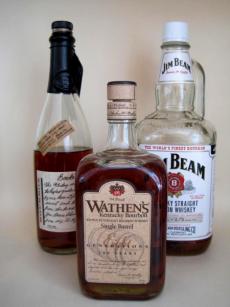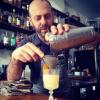
Bourbon is the name of a class of distilled spirits made primarily from corn, and regulated by Federal law with regards to its composition, distillation, aging, and labelling requirements. Along with apple brandy, Bourbon was one of the first things distilled in this country, though its true origins are lost in the mists of time.
Bourbon was named after Bourbon County, Virginia, which in turn was named for the Bourbon family, who were kings of France at the time. Bourbon County was delimited in 1785, so that gives us a firm starting date. Eventually, Bourbon County was broken away from Virginia to form the new state of Kentucky, and was further reduced to make what is today, 34 counties. Ironically, no Bourbon is produced in Bourbon county, Kentucky.
There is some debate as to who first began distilling Bourbon. Some candidates include the Reverend Elijah Craig (who aged his whiskey in charred oak barrels), Jacob Spears, who may have been the first to label his whiskey as Bourbon, and Evan Williams, who owned the first distillery in Kentucky.
Like most distillation in the 18th century, it began as a way to preserve excess crops, and had the added advantage that it was easier to transport and sell than the original grain. At this time, corn was the local staple crop, so it was converted into whiskey. An enzyme in malted barley (amylase) is necessary to convert starches to fermentable sugars, so that was added as well. Rye was probably added for flavor and spicy notes. These were all aged in charred barrels made from local wood.
One of the 19th century innovations in the production of Bourbon is attributed to either either James C. Crow or Jason S. Amburgey. The sour mash process holds back some of the spent grain from a previous batch of fermentation and adds it to the new batch. This not only kickstarts fermentation, but the natural souring of the mash provides the proper pH for beneficial yeasts to drive the fermentation process. This ultimately leads to consistency of the resulting whiskey.
In 1964, Congress passed a bill declaring Bourbon to be a distinctive product of the United States, in the same way that Scotch Whiskey is a product of Scotland.
While Bourbon can be made anywhere in the United States, 95% of the production comes from Kentucky. Federal law defines how Bourbon made for consumption in the United States must be made:
- It must be made in the United States
- It must be at least 51% corn, and no more than 80% (at which point it becomes "corn whiskey")
- It must be aged in new, charred oak barrels
- It must be distilled to no more than 160 proof, and aged at no more than 125 proof
- It must be bottled at 80 proof or more
In addition to those rules, there are also labelling requirements for Bourbon, as long as it meets the above standards:
- If it has been aged for two years and no colored or flavored, it may be called Straight.
- Straight Bourbon aged less than four years must have the age declared on the label.
- If a Bourbon has an age statement on the label, it must be the age of the youngest Bourbon in the blend.
- A Bourbon labelled as Blended must be at least 51% Straight Bourbon, but can be colored, flavored, or contain neutral spirits.
- Bourbon sold at under 80 proof must be labelled as Diluted Bourbon.
- Bourbon labelled as Bottled in Bond must be the product of one distiller and one distillery in one season, and must be aged for at least four years in a Federally recognized warehouse and bottled at 100 proof.
The common mash bill for Bourbon is around 70% corn, with 5% barley, and the remainder either rye, wheat, or both rye and wheat. Some producers favor a high percentage of rye in their Bourbon. One example of this is [ingredient=bulleit Bulleit], which is 28% rye. Bourbon is aged in what are called rickhouses - typically metal roofed multi-storied buildings that can have dramatic variances in temperature. Higher temperatures means accellerated aging, and so it is the job of the Master Blender to take barrels from different parts and heights of the rickhouse and blend them together to provide a consistent product.
A sub-category of Bourbon called [ingredient=tennessee-whiskey Tennessee whiskey] is made in Tennessee. People who believe that Tennessee whiskey is a separate category will point to the Lincoln County Process as what sets their whiskey apart from Bourbon. The Lincoln County Process involves filtering the whiskey through many feet of hardwood (usually maple) charcoal. The problem with this is that not all Tennessee whiskies undergo the process. Of the four producers of Tennessee whiskey, Pritchard's does not go through the Lincoln County Process.
While there are hundreds of brands of Bourbon, there are surprisingly few distlleries currently in production. In Kentucky, for example, Brown-Forman owns the Brown-Forman distillery and Woodford Reserve. Fortune Brands owns the Jim Beam and Maker's Mark distilleries. There are the Four Roses distillery (owned by Kirin), the Wild Turkey distillery and the Heaven Hill/Bernheim distillery. Sazerac owns the Tom Moore distillery and the Buffalo Trace distillery.
Some of the more common Bourbon brands include:
- Ancient Age
- Baker's
- Basil Hayden's
- [ingredient=bookers Booker's]
- Buffalo Trace
- [ingredient=bulleit Bulleit]
- [ingredient=eagle-rare Eagle Rare]
- [ingredient=elijah-craig Elijah Craig]
- Evan Williams
- Ezra Brooks
- [ingredient=four-roses Four Roses]
- George T. Stagg
- [ingredient=jim-beam Jim Beam]
- Knob Creek
- [ingredient=makers-mark Maker's Mark]
- [ingredient=michters Michter's]
- Old Forester
- Old Granddad
- Pappy Van Winkle
- Rebel Yell
- [ingredient=wild-turkey Wild Turkey]
- [ingredient=wl-weller W.L. Weller]
- [ingredient=woodford-reserve Woodford Reserve]
Outside of Kentucky, Tuthiltown distills Bourbon in New York, and Garrison Brothers distills Bourbon in the small town of Hye, Texas (near Johnson City).
Some popular cocktails containing Bourbon
- Walker Percy's Mint Julep — Bourbon, Simple syrup, Nutmeg, Mint
- Rhubarbaration — Bourbon, Zucca, Rhubarb syrup
- Old Dutchman — Bourbon, Blackstrap Bitters, Red Birch Beer, Maple syrup, Cinnamon stick, Brandied cherry
- Hulk Smash! — Bourbon, Bitters, Nin Jiom Pei Pa Koa, Water, Lime, Mint
- New Jersey Transit — Bourbon, Bitters, Orange bitters, Apple cider, Demerara syrup, Orange peel
- Clemen-thyme Sour — Bourbon, Amaro Montenegro, Lemon juice, Citrus fruit, Egg white, Sugar, Thyme
- Augusta Punch Shot — Bourbon, Apple brandy, Peach bitters, Tea, Lemon juice, Oleo-saccharum, Peach
- Full Circle — Dominican Rum, Bourbon, Amaretto, Bitters, Grapefruit cordial
- Chai-Town Brown — Bourbon, Bitters, Allspice Dram, Grade B maple syrup
- Dream Catcher — Bourbon, Zucca, Rhubarb bitters, Lemon juice, Strawberry syrup
Fred - as usual, you are right. I went back and checked the Standards of Identity. We regret the error. Zachary

"It must be at least 51% corn, and no more than 80% (at which point it becomes "corn whiskey")"
False. It can be 100% corn. The difference is that Bourbon is new charred cooperage whereas corn whiskey is either unaged (the only American spirit that can be called whiskey without aging), aged in uncharred barrels, or aged in used barrels.